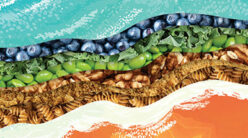If you are a vegetarian, the thought of having a food-borne illness probably never crosses your mind. After all, everyone knows that E. coli makes its home in raw beef, and Salmonella breeds rapidly in undercooked chicken or pork.
Well, it’s time to rethink your past beliefs about food-borne illness, as fresh fruits, vegetables, eggs, lentils, and dairy products can also play host to a variety of deleterious bacteria, including E. coli and Salmonella. In fact, some of the most common carriers of food-borne germs include basil, cantaloupe, lettuce, potatoes, raspberries, scallions, strawberries, and tomatoes.
According to the Centers for Disease Control and Prevention (CDC), food-borne diseases cause an estimated 76 million illnesses, 325,000 hospitalizations, and 5,200 deaths in the United States each year. Not only are the symptoms uncomfortable; food-borne illnesses can lead to secondary long-term illnesses. For example, there are some strains of E. coli that can cause kidney failure in young children, while Salmonella can lead to reactive arthritis and serious infections. For pregnant women, the Listeria bacteria (commonly found in soft cheeses such as brie and feta) can cause meningitis and stillbirths.
What Causes It?
You encounter thousands of types of bacteria in your everyday environment; most of them cause you no harm. For instance, the bacteria in yogurt is “good” bacteria and benefits your body. But when harmful bacteria (also called pathogens), such as Listeria, Salmonella, and E. coli 0157:67 enter our food or water supply, they can cause problems ranging from flulike symptoms to incurable illness to death (see sidebar on page 13 for a list of common symptoms). Sometimes even the bacterial poisons or toxins produced by germs such as Staphylococcus aureus or Clostridium botulinum can result in food-borne illness. Three of the most common types of food-borne bacteria that affect vegetarians include the following:
- Campylobacter, the most common cause of diarrhea and abdominal cramps from food-borne illness. While most raw poultry meat has Campylobacter on it, vegetarians should be concerned if food becomes contaminated with juices dripping from raw chicken, such as a salad or vegetable dish cooked while someone prepared a chicken dish. Unpasteurized milk or contaminated water may also cause this infection.
- Escherichia coli 0157:H7, which causes an estimated 73, 000 cases of infection and 61 deaths in the United States each year. While most strains of E. coli live in the intestines of healthy humans and animals, the 0157:H7 strain can be deadly, leading to bloody diarrhea and even kidney failure.
- Salmonella enteritidis, a bacterium that can cause illness if raw or undercooked eggs are eaten. Salmonella infection can lead to fever, abdominal cramps, and diarrhea within 12 hours to three days after eating the contaminated food. In some high-risk people (the elderly, pregnant women, infants, and those with compromised immune systems), Salmonella bacteria can lead to hospitalization and even death.
If you suspect a food-borne infection, you need to seek medical care. Your doctor will culture a stool sample to identify the particular bacteria; then treatment will follow, depending on the pathogen and your symptoms. Experts believe that many people who have diarrhea or vomiting assume this is a “virus,” and let it run its course instead of getting an accurate diagnosis. For this reason, the CDC estimates that 38 cases of salmonellosis actually occur for every case that is diagnosed and reported to public health authorities.
Who’s at Risk?
If you eat food, you are at risk for food-borne illness. Yet those at highest risk include infants, pregnant women, the elderly, the chronically ill, and those with compromised immune systems. While there are more than 250 different types of food-borne diseases causing such symptoms such as diarrhea, vomiting, and body aches, this is one common illness you can avoid–if you understand the rules. Consider the following six steps as you protect yourself and your family from unnecessary illness.
Step 1: Watch what you buy.
Make sure the food you buy at the grocery store is the freshest available. Check the package for expiration or “use by” dates, and make sure you will have time to eat the food before it needs to be thrown out. When this date expires, throw the food away to be safe.
When buying eggs, open the carton and inspect each egg for cleanliness. Make sure the eggs have no cracks or thinness in the shells. Select cheese that is fresh and has no unusual mold or discolored spots. Dairy products should be dated and pasteurized.
Avoid buying fruits or vegetables that are slippery, moldy, or have a funny odor. And never eat fresh fruits or vegetables in the store, as you have no idea what types of germs or pesticides may be on them.
Step 2: Always wash fresh fruits and vegetables (even if they come in prewashed packages).
Fruits and vegetables can harbor some of the most deadly food-borne pathogens, particularly if they are washed or irrigated with water that is contaminated with animal or human feces. These germs can get into fruits and vegetables during processing or packaging. And if the workers who packed the fruits and vegetables into crates are ill, these germs go right onto the foods they are touching.
You’d never know by the dark-green skin of the fresh cabbage that it also harbored deadly bacteria. That’s why a good scrub of all fresh fruits and vegetables is mandatory to remove germs and avoid illness. This means scrubbing the skins of fruits such as cantaloupe or watermelon before cutting them, and rewashing apples, pears, or oranges even if you washed them prior to placing them in the fruit bowl. It also means rewashing any prewashed packaged salads before serving, to remove bacteria and pesticides that remain on the leaves. Also remove the outer leaves of cabbage and lettuce to get rid of dirt and pesticides. Take special care when washing fruits and vegetables such as parsley, lettuce, or any type of greens (mustard, collards, kale, turnips), which are harder to clean thoroughly than fruits and vegetables with smooth skins.
If you or a family member is at higher risk of a food-borne illness, make sure you serve cooked fruits and vegetables, particularly if they are grown in or on the ground. Peeled fruits and vegetables (like bananas and oranges) are less risky than fruits and vegetables that are not peeled before eating.
Step 3: Be aware of specific “at risk” foods.
There are certain risky foods that you need to be cautious about, such as bean sprouts. No matter how fresh, even after the seeds are sprouting, the dangerous bacteria continues to grow and may carry food-borne pathogens that can make you ill. (Sprouts that have been cooked are not risky.)
Raw eggs are another risky food and should be avoided at all costs. Even scrumptious homemade cookie dough made with raw eggs can put you at risk of illness if you take a lick before cooking and the Salmonella bacteria was hiding inside the egg–and you would not know if it had this bacteria until you became ill. (Packaged cookie dough is safe to eat raw because the manufacturer uses eggs that are pasteurized, a process in which the bacteria is destroyed using heat.)
Be sure to keep eggs refrigerated and discard any cracked eggs, and wash your hands and any cooking bowls or utensils with warm water and soap after contact with raw eggs.
Other “at risk” foods include juices that are not pasteurized. During the pasteurization process, any food-borne bacteria is killed. Yet juices that are fresh and not pasteurized may harbor
E. coli and Salmonella. If you want to drink a freshly squeezed fruit juice, bring it to a boil first to kill the germs.
Step 4: Cook foods thoroughly.
Foods must be cooked thoroughly to kill any dangerous bacteria. Eggs must be cooked until the yolk is firm to be safe. If you use a microwave to cook an egg dish, watch out for “cold spots” after cooking–areas where the food did not heat to a proper cooking temperature. If you do not have a turntable, turn the dish by hand several times during the cooking process. Also stir the dish at the halfway point to ensure that all ingredients are thoroughly cooked.
If you are reheating a dish, bring leftovers to 165°F to kill bacteria. Sauces and soups should be brought to a boil when they are reheated.
Step 5: Keep hot foods hot and cold foods cold.
The food safety rule is to keep hot foods hot and cold foods cold. While foods may be safe immediately after cooking, if you allow them to stay on the counter for longer than two hours, noxious bacteria can start to reproduce. For instance, under warm, moist conditions and the proper nutrients, one bacterium that reproduces by dividing itself every half hour can produce 16 million offspring in a period of 12 hours.
Play it safe by carefully wrapping and storing cooked foods in the refrigerator (40°F) within one to two hours after cooking. If you are storing a large casserole, divide this up into smaller dishes so it can cool quickly. When large dishes are stored, bacteria has a better chance to grow because the cool- down refrigeration process takes longer.
Step 6: Use healthy hygiene.
The last simple step to avoid food-borne illness is perhaps the most basic: use healthy hygiene. This means washing your hands and doing it frequently. Most people have no idea how many bacteria they have on their hands that is spread to others during food preparation. Consider the mother who changes the baby’s diaper and then quickly hands her preschooler an apple before washing her hands. Or what about the teenager who cleans out the cat’s litter box and then pops a few grapes in his mouth before heading to the bathroom to wash his hands? While these scenarios sound distasteful, they happen all the time to almost all of us.
A good rule of thumb is to wash your hands for at least 20 seconds with soap and warm water. Rub them together, as the friction of skin against skin will enable you to remove the germs. Wash your hands after using the bathroom, before and during food preparation, before feeding a baby, after changing a baby’s diaper, before giving your child a piece of fruit, and after petting the family dog–among other times. If you sneeze into your hands, wash them! Likewise, if you use the telephone after someone who has a cold, wash your hands again. Keeping your hands clean will help to reduce the bacteria count and keep you from spreading these germs during food preparation.
It’s also important to keep your kitchen sink, drain, and counter tops clean and disinfected before food preparation. Most popular disinfectants available at your grocery store suffice in killing germs. Make sure your cutting boards and utensils are clean by washing with warm, soapy water and running them through a cycle in your dishwasher. Also put your kitchen sponge in the dishwasher each night to help keep bacteria at bay, and change dish towels nightly.
With just a few simple changes in the way you treat food, you can keep dangerous food-borne pathogens from infecting you or your family members.






